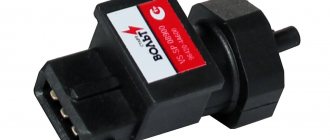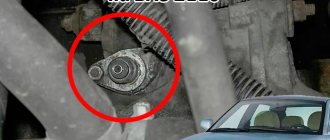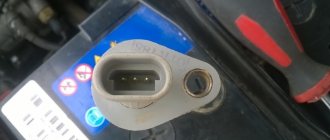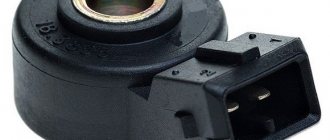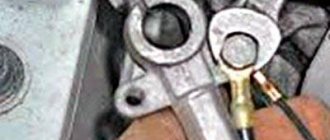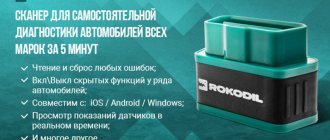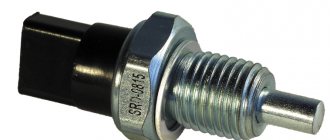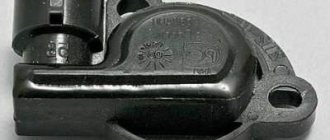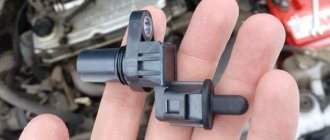Print this article Font size 16
Every car, regardless of its class, manufacturer or country of origin, must have a system that is responsible for speed readings and the number of kilometers traveled. VAZ 2110 is no exception. But only on injection.
Speed sensor
Carburetor models use a cable mechanical speedometer system, so there is no speed sensor. It's simply not needed.
Other deviations
We have discussed the possibility of replacing a device if it is not functioning, but it often happens that the data is displayed on the dashboard incorrectly. For example, a driver drives at the maximum permissible speed limit, but at the same time he constantly receives fines for violations. Of course, you can drive with such a device, roughly focusing on the deviation indicators, but it is best to adjust it.
To do this, let's look at the types of speedometers. Mechanical speedometers are installed on 8-valve engines. They are equipped with a carburetor system. Sometimes options for installing additional electronic devices are possible. In these variants, pointer instruments are used; their malfunction can be identified due to deviations. There are three types of deviations:
- The arrow is in position 0;
- The arrow is in one position;
- The arrow constantly changes readings.
If the arrow is at zero, then the previous options can be used for repairs. If the needle readings are unstable, or if it hangs in a chaotic position, there is a possibility that the speed sensor is faulty. In such cases, in addition, the odometer does not work and because of this the driver cannot determine the number of kilometers traveled. In order to understand that the engine is in a faulty state, it is worth monitoring the operation of the engine. If the motor may stall on its own at some points, or its operation is unstable and the engine begins to trip, then this may be the result of a breakdown. Also one of the reasons may be increased gasoline consumption. For more accurate readings, you can run car diagnostics when errors p0501-p0503 are displayed - the reason will lie precisely in the failure of the DS. If the failure of the DS is electrical-related, then a check light will light up on the dashboard.
In this case, you can dismantle the device and use a screwdriver to recreate the rotation of the core. It is necessary to rotate counterclockwise. At the same time, we constantly monitor the readings of the multimeter. The lower voltage should be 1 V, and the upper voltage more than 5. Rotate the wheel, with each rotation the device should display 6 pulses. If the signal appears, but the speedometer of the VAZ-2110 does not work, then the problem may be in the sensor drive. In this case, it would be best to replace it.
On carburetor engines with 8 valves, everything is much simpler. A cable is connected to the gearbox, which controls the position of the arrow. Therefore, to diagnose it, it is enough to disconnect it from the gearbox and look at its integrity. We inspect the end of the cable, and more specifically the tetrahedron. If there is no mechanical damage on it, then everything is intact. After this, we turn the tip and monitor the readings on the dashboard. If this starts to pick up speed, then everything is in order, but if it rotates freely, incorrect readings may occur.
Vehicle traffic control
This function is performed by the speed sensor, which takes part in the formation of the fuel mixture by the controller. It replaced the mechanical cable drive previously installed on carburetor VAZ 2112 models. The operating diagram of the element is as follows:
- The speed sensor is driven from a shaft located inside the gearbox.
- From the controller side, the device receives a reference voltage of 12 V.
- In response, the sensor produces a signal in the form of a pulse of a certain frequency. The frequency varies depending on the speed of the car.
- Based on these pulses, the controller controls the speed indicator and odometer on the dashboard, and also creates a rich or lean fuel mixture for the engine.
A malfunction of the speed meter is indicated by such signs as failure of the speedometer, unstable operation of the power unit and loss of idle speed when coasting. An indirect sign may also be the short-term display of the “Check Engine” sign on the instrument panel.
If you pay closer attention, increased gasoline consumption will become noticeable. If the sensor fails, you can continue driving, but you should replace it as soon as possible
The product cannot be repaired.
The device itself is a plastic box with a drive, from which wires come out in a bundle with a connection block. The block can be round or rectangular depending on the manufacturer of the product. The block from the Bosch brand is rectangular, from General Motors it is round.
A few words about how to check the speed sensor. The ideal option is to connect a laptop with the installed program for the VAZ 2110-2112 to the controller via the appropriate connector. But at home, the average motorist may only have a multimeter, and with its help he will have to test the operation of the element.
To do this, one front wheel of the car is suspended with a jack, and the wires leading to the controller are disconnected from the sensor. Instead, you should connect a multimeter and, by manually rotating the wheel, make sure that the readings change along with the rotation speed. If there are no changes, then it is better to change the product, otherwise, with such driving, more serious repairs will occur with the replacement of engine parts.
How to diagnose a problem
There are only 3 ways to check the tens speed sensor. One of them involves the use of a control lamp, the other two are based on a circuit.
But before moving on to any of them, make sure that there is grounding and voltage on the contacts; to do this, disconnect the electrical connector from the sensor by simply squeezing the “antennae” and removing the chip, and ring each of them. One of the contacts should show a voltage of 12V.
If everything is fine with the power supply, proceed directly to the diagnosis itself.
Method No. 1 - carried out according to the above scheme without removing the sensor from the car. Jack up the front wheels. Using regular wires (if you have an assistant) or with alligator clips (if you don’t have an assistant), connect the voltmeter to the speed sensor, not forgetting to supply current to it. Place the gearbox in 5th gear and rotate the wheel. If everything is in order with the sensor, in response to these actions you will see changes in the voltage of the pulse contact - between the output and ground - the higher the speed, the greater the voltage. The range of changes is 0.5-10V.
Method No. 2 - carried out according to the above diagram on a sensor removed from the car. Remove the speed sensor (how to do this will be described in detail below in the instructions for replacing it). Using wires, again repeat the above diagram. Take a tube, pliers or any other handy item that allows you to rotate the sensor axis (the main thing here is not to forget about safety precautions), and rotate the sensor around its axis. The resulting multimeter readings (from 0.5V to 10V) will indicate that everything is in order with the sensor.
Method number 3 – “light bulb test”. Applies to the speed sensor without removing it from the vehicle. Using a jack, raise the drive wheels on the ground. According to the diagram below, connect a light bulb to the element being diagnosed. Place the gearshift lever in 5th gear and rotate the wheel. The light should blink. If this does not happen (if there is voltage in the network, of course), the sensor should be replaced.
Checking induction DC and with reed switch
Note that speed controllers differ in the signal coming from the wheels. Taking this fact into account, the DS check is also built:
- WITH REED SWITCH. The signals are rectangular in shape. The cycle is from 40 to 60 percent. Switching occurs at a voltage from 0 to 5 Volts or when the battery voltage is reached.
- INDUCTION. With these speed sensors, the signal is in the form of waves, so the voltage changes based on the speed at which the wheel spins. This can be seen on the oscilloscope. Otherwise the principle is identical to what happens on the crankshaft angle controller.
DIY repair and replacement
If you decide to replace the device yourself, familiarize yourself with the removal and replacement procedure.
The controller is dismantled as follows:
First you need to de-energize the vehicle's on-board network; to do this, disconnect the negative cable from the battery. Next, disconnect the connector with wiring from the controller itself. At this stage, it is important to remember what pinout these elements have. The controller itself can be unscrewed by hand. If you can’t do this on your own, try using a 21 or 22 wrench. In this case, the regulator may have certain differences in design. Also immediately check how well the drive functions. After the regulator is removed, it is necessary to unscrew the nut that secures the drive to the gearbox
The dismantling procedure must be done very carefully, because if you accidentally drop the rod into the transmission, the box will need to be removed and disassembled. As for the new drive, it is equipped with a rubber seal
Before installation, it must be lubricated with transmission fluid. Below is a video that will allow you to more clearly understand the procedure for replacing the controller (the author of the video is Auto News).
All new components must be installed in reverse order. Again, in this case the wiring pinout plays a big role. Inside the block itself you can see how the pinout is indicated. Using a tester with the ignition activated, it is necessary to determine which connector the drive should be connected to.
If the multimeter shows “-” and the drive was connected to the positive connector, this indicates that the polarity needs to be changed. Next, the drive is diagnosed, and you should also check the operation of the speedometer while driving or with the front of the vehicle raised (so that the wheels are suspended).
If you doubt that you can carry out the entire procedure yourself and change the controller correctly, we advise you to seek help from specialists. In principle, this process is not particularly complicated, so the cost of the replacement service will not be particularly high. For installation, it is better to use a higher-quality regulator so that in the future you do not face the need to repair and replace it.
Replacing a car speed sensor
As for its location, look for the DS in the engine compartment in close proximity to the exhaust manifold. To be honest, the place where it is installed cannot be called ideal. While the car is running, the manifold heats up. The sensor wires rub against it, which over time leads to malfunctions and short circuits. Therefore, experts recommend that the first step is to properly insulate the wiring, and also use some kind of clamps so that the wires do not come into contact with the collector. This significantly extends its service life.
It doesn’t matter whether you have an injection car or a carburetor with a Europanel - the connection of the speed sensor to the instrument cluster is identical.
Replacing the VAZ speed sensor: step-by-step instructions:
- Drive into the pit - it will be more convenient to work from below - and wait until the engine cools down.
- Turn off the vehicle's power by removing the cable from the negative terminal of the battery. Do not close the hood after this, this will provide you with lighting.
- Locate the speed sensor on the transmission. Clean it and everything near it with a rag to remove any dirt.
- By pressing the spring clip, disconnect the wire block from the sensor.
- Dismantle the sensor itself by unscrewing it counterclockwise - with your fingers or an open-end wrench to “22”.
- Carefully, so as not to break anything, install a new part in place of the removed part. Connect the wire block to it and the procedure for replacing the speed sensor can be considered complete.
How to properly connect a new DS? It is important here that the device rod fits correctly into the fixing sleeve, otherwise rotation will not be transmitted to the sensor. If the sensor fits into the socket the first time, then everything is in its place, and if something prevents it from moving, then the rod did not get into the bushing
The speedometer is installed on any modern car; it can be of various types - liquid crystal, pointer, indicator. If the device stops working, it becomes more difficult for the driver to navigate by speed, and it is easier to break the speed limit. Types of speedometers VAZ-2110
Speedometers on the VAZ-2110 car come with electronic and mechanical drives; devices of the second type were installed on cars of the first years of production with carburetor engines (8 valves). Later, the “ten” began to use electronic speedometers; torque is transmitted from the gearbox to the dashboard through a speed sensor.
Some recommendations
- The search for the cause of the speedometer's inoperability should begin with an external inspection of the DS and the wires going to it. Wires often break in close proximity to the plug.
- If the speed sensor is covered with a layer of dirt or oily, you need to remove it, wipe it, reinstall it and check the speedometer readings again. Perhaps after this the instrument needle will again begin to show speed normally.
- If you cannot figure out the problem yourself, you should contact an electrician at a car service center.
Speed sensor
Carburetor models use a cable mechanical speedometer system, so there is no speed sensor. It's simply not needed.
Symptoms of problems, checking the speed sensor
If the odometer is not working, and the speedometer is “jerky”, transmitting false speed or mileage readings, we can conclude that the speed sensor is faulty.
There is also the possibility that these are signs of electrical circuit problems, especially if the car has ever been tampered with. There may be a break or oxidation of the connectors, rubbing of the wiring insulation, which causes a short circuit.
Also, a sign of breakdowns are cases in which the car may stall at idle. Perhaps the most obvious symptom of a speed sensor failure will be incorrect speedometer readings and the “ChekEngine” light on the panel.
These devices have three contacts: ground, pulse signal, voltage. First, you should check the functionality of the grounding and the presence of voltage.
To check the speed sensor you need:
- Remove this sensor;
- Using a multimeter, calculate the contact that produces a pulse signal. “We install a plus to it, and attach the minus to the body of the car.
- Carefully rotate its rod. At the same time, you should monitor the output signal. If the sensor rod starts to rotate faster, the voltage will be higher.
Replacement or repair methods
Disassembly and removal is carried out as follows:
1. Remove the negative connector from the battery, having previously de-energized the car;
2. The wire connector is separated from the sensor;
3. The sensor is sometimes unscrewed by hand, but if it is difficult, you can unscrew it using twenty-one-twenty-two keys (sensors may vary in design);
4. We diagnose the drive condition
When removing, be careful, because when the drive rod breaks, there is a danger of dropping it into the gearbox; it can only be retrieved by disassembling the gearbox
The old sensor cannot be repaired. The new sensor should be installed using the reverse sequence shown. Don't forget to put the connector block on the sensor. Good luck on the roads and of course no breakdowns.
Do I need to change
Not only the speedometer and odometer readings, but also the quality of the fuel mixture supplied to the cylinders, the idle speed of the vehicle, engine stability and fuel consumption depend on the information received by the ECU from the sensor.
A failed DS will “confuse” the electronic unit, which simply will not understand whether the car is moving or standing still. As a result, the speed will begin to fluctuate, the engine will stall at idle, and fuel consumption will increase.
Checking a mechanically driven speed sensor is not difficult. On the removed sensor, we find the pin and turn it with pliers, having attached the connector to it in advance. If the speed sensor is working, the arrow on the instrument cluster will jump, if there is no reaction, then there is a problem with the drive or electrical wiring.
Checking the wiring to the instrument cluster is also not difficult, take a paperclip (you can use any other metal object) and insert it into the middle pin on the connector, then touch it to the engine housing, the arrow on the combination should twitch, otherwise you need to look for the cause in a wiring fault or sensor connector (oxidation, breakage, etc.).
What else is the reason for the speedometer not working?
However, often the reason for the speedometer malfunction lies elsewhere:
- Oil and dust get into the speed sensor, which is located in the engine compartment under the hood of the car.
The malfunction is eliminated after removing dirt and oil by washing the sensor. If the DS fails and needs to be replaced, any car owner can perform this simple operation independently.
The replacement sequence is as follows:
- place the machine on a flat horizontal surface;
- open the hood and find the speed sensor on the gearbox;
- by pressing the latch bracket, the plug is disconnected from the DS:
- to remove the sensor, use a 22 mm wrench, turning it counterclockwise;
- The new part is installed by screwing it in by hand. The use of a wrench is not recommended, as you may miscalculate the rotation and break the thread;
- install the connector, as evidenced by the click of the fixed part.
The driver should buy a new DS with similar markings. Otherwise, the speedometer needle will display incorrect readings.
- For some unknown reason, the VAZ 2110 speedometer stopped working. First of all, you need to check the most accessible elements associated with the speedometer. Since the car compartments are not ideally clean, dirt and moisture can damage any part, including wires and contacts.
Under the influence of moisture and dirt, wires and contacts can oxidize. Eliminating this cause is simple: the contacts must be removed, cleaned of oxidized deposits, wiped dry and reinstalled.
It is also necessary to check the integrity of the wires. Externally good wires may have broken sections of cores inside. Checking the serviceability of the wires involves ringing their surface with a tester.
During operation, the splines and elements that rotate the speedometer cable may be damaged. Such a defect may impair the operation of the instrument panel. You can verify its serviceability by testing it.
- The third, very important defect is the malfunction of the speed sensor. This device is located on the gearbox, adjacent to the exhaust manifold. This factor leads to heating and chafing of the DC wires.
The reasons for the sensor being out of working condition, the fault can be determined at the service center. The technician will perform this procedure in the presence of the car owner.
To troubleshoot the problem yourself, you should do the following:
- The speed sensor must be removed by unscrewing it from the gearbox;
- connect the DC wire to a screwdriver or drill, set the rotation counterclockwise;
- turn on the ignition.
The movement of the arrow indicates that the sensor is working properly. The weak link is most likely located in the vehicle's transmission. It is difficult for a driver without experience to cope with this task. In this case, the problem must be solved by car service specialists.
If the speedometer needle on a VAZ 2110 does not work, the speed sensor must be replaced.
The speedometer on a VAZ 2110 with an injector is an important element of any car, not excluding the “top ten”. VAZ 2110 drivers even with little experience can check and find the source of the malfunction of this device.
However, if you cannot determine the source of the speedometer problems, you need to draw the attention of technical service specialists to this problem.
Preparing for replacement
In order for the procedure for replacing the controller on the tenth VAZ model to proceed correctly and to obtain the expected result, namely the normal functioning of the speedometer, you should be properly prepared for this process.
Firstly, on a VAZ 2110, replacing the DS means purchasing a new controller
When purchasing a new regulator, you need to pay attention to the fact that each connector located in the block design has certain symbols. It should contain the symbols “-”, “A” and “+”, not numbers
In principle, in this case there is not much difference between these options; when connecting the connector you will have fewer problems with pinout. If you have never encountered a process like this, this pinout will allow you to complete it correctly.
Controller connector pinout
One more, no less important nuance. You need to buy a device that is equipped with a metal rod. This rod will last at least six months, which cannot be said about regulators with plastic rods. In addition, when purchasing, you must check whether the rod rotates or not. It should not rotate, there should be no play on this element, and it should also be equipped with a washer.
Wiring pinout, what to pay special attention to when using a multimeter
Pay attention to the pinout inside the block. With the ignition on, use a multimeter to determine which connector is connected to which wire.
If you connect the wire to the “plus” connector, and the multimeter shows “minus”, then you should urgently change the polarity. Therefore, it is advisable to take a block with the appropriate designations. But if this doesn’t happen, you can take the regular one. In this case, the pinout is as follows - 1 is “+”, 2 is “signal output”, and 3 is “-“.
Speed sensor pinout
If you understand how to connect a speed sensor, you should know that these devices differ in the degree of connection. There is the following pinout of the VAZ 2110 speed sensor, which should be followed
In this case, it is very important to study the circuit diagram of the speed sensor, which is attached to this article
The factory speed sensor of VAZ 2110 cars is manufactured with some differences in connections to the shoe connector. The square-shaped connector is used in Bosh electronics systems. The circle-shaped connector is used in electronic systems such as January 4 and GM.
When connecting a speed sensor, you should choose devices with contact group digitization such as “-”, “A”, “+” (internal designation on the block contacts) instead of digital designations such as “1”, “2”, “3”. In addition, preference should be given to devices with a metal-type rod, since plastic rods are very short-lived.
Having decided to buy a speed sensor for a VAZ 2110, you should check the rod of the device with rotational movements and its backlash, which should be kept to a minimum, as well as the presence of such a part as a spacer washer on the rod of the product.
Pinout DS 2109, 2110, 2112, 2114, 2115
If you understand how to connect the speed sensor, then there is the following pinout that you should follow
At the same time, it is important to understand the essence of the operation of the DS to study the circuit diagram of the sensor, which is attached to this article
The factory speed sensor of VAZ cars is manufactured with some differences in connections to the block connector. The square-shaped connector is used in Bosh electronics systems. The circle-shaped connector is used in electronic systems such as January 4 and GM.
When connecting a sensor, you should choose devices with contact group digitization such as “-”, “A”, “+” (internal designation on the block contacts) instead of digital designations such as “1”, “2”, “3”. In addition, preference should be given to devices with a metal-type rod, since plastic rods are very short-lived.
Preparatory activities
Proper replacement of the speed sensor on a VAZ 2110 implies the mandatory purchase of a new device that meets all the requirements of your car.
Connector
Basically, when purchasing a device, follow two basic rules.
- Choose a sensor whose connectors inside the block are marked -, A and +. Usually the designations 1, 2 and 3 are used there. There is no fundamental difference between them, it will simply be much easier to carry out the pinout with such markings. It is the incorrect connection that often becomes the reason that you have to seek help from a service station. And these are completely different financial costs.
- The rod on the element must be made of metal. If the stem is plastic, it will last you about 6 months. It is not in your best interest to replace regularly. But don’t forget to check the metal rod for play, correct rotation, and the presence of a washer in the package.
Replacement
Now to the question of how to make replacements. To do this, we dismantle the old device and connect a new one in its place. Your steps look like this step by step:
Remove the negative cable from the battery, which will allow you to turn off the power to the car; Now disconnect the wires from the sensor and be sure to remember what form the pinout was in; The device can be dismantled by simply twisting it by hand. There is usually no need to use any tools. But if the device fits tightly, then use 22 or 21 millimeter keys. Depending on the modification of your “ten”, the design of the sensor may differ slightly; At the same time, we recommend checking the wiring; After removing the meter, unscrew the fixing nut that holds the wire going to the gearbox; Remove carefully so as not to drop the rod into the box. If this happens, you will have to completely disassemble the gearbox.
This is clearly not in your best interest; A new device with a rubber ring must be lubricated with transmission fluid so that the fixation in the new place is as reliable as possible; Assembly is performed in reverse order; Pay special attention to the pinout. Connect the multimeter with the ignition on
If the device showed “minus”, then you connected the wire to positive, which is absolutely not allowed. This is why we initially advised using a sensor that is not labeled 1, 2, or 3.
If you couldn’t avoid using a new device with inconvenient markings 1, 2 and 3, then remember an important pinout detail:
- 1 corresponds to “+”;
- 2 denotes signal output;
- 3 is “-“.
>
Installing a new element
Before replacing the speed sensor, you should purchase a new element that matches the shape of the connector. It is necessary to take into account an important point: on the connecting block of the factory product, near the contacts, the marking numbers “1”, “2” and “3” are marked. But on sale there are more often sensors where a different marking scheme is adopted; instead of numbers there are symbols “-”, “+” and “A”. There is no tragedy in this, you just need to know that the new speed sensor pinout is combined with the old one as follows:
- the symbol “+” and the number “1” are the same thing;
- the symbol "-" means "3";
- the letter “A” is the output wire, corresponds to the number “2”.
https://www.youtube.com/watch?v=qiDmZLUuTMI.
Replacing the sensor is a simple task, performed in the following sequence:
- Turn off the ignition and remove the negative contact from the battery.
- For ease of access, disconnect and remove the air filter along with the air duct pipe.
- Disconnect the connection block.
- Unscrew the element, grabbing it by the edges with a 22 key.
- Clean and wipe the area from dirt, screw in the new sensor along with the gasket.
https://www.youtube.com/watch?v=x_BfBpNW9zEWhen finished, connect the wires, put the removed parts back in place and check the functionality of the sensor while driving using the speedometer.
Any car is equipped with a system that shows the speed of movement and mileage (distance traveled). It is the speedometer, which is a device for determining instantaneous speed, that makes it possible to find out what the maximum speed of the VAZ 2110 is.
Speed sensors are installed only in fuel-injected cars; where carburetor engines are present, they are not present. This device is responsible for the supply and consumption of fuel, setting the ignition timing, and monitors the quality of the combustible mixture. All data is transmitted to the electronic control unit, which controls the injector.
Before the advent of sensors, mechanical speedometer drives were installed on each carburetor engine. On VAZ 2010 cars produced before 2006, mechanical drives are installed. Newer cars manufactured after 2006 are equipped with electronic sensors.
Speed sensor on a VAZ 2110 - how to determine the fault, replace it yourself
The speed sensor (DS) is designed to obtain information about the number of revolutions transmitted from the gearbox to the drive wheels of the vehicle, followed by its conversion into an electronic signal and transmission to the electronic control unit (ECU). Only fuel-injected cars are equipped with DS. The predecessor of the speed sensor was a mechanical speedometer drive, which was equipped with all carburetor engines.
VAZ 2110 cars, depending on the year of manufacture, are equipped with different types of speed sensors. Older models are equipped with a mechanically driven sensor (rod and gear), new ones (after 2006) have a fully electronic design.
What is it for?
The speed sensor has a lot of work to do. It informs the electronic control unit about the correct fuel supply, determines and sets the ignition timing, and is responsible for the quality of the air-fuel mixture.
Scheme
The sensor collects all kinds of data and transmits them in the form of signals to the electronic control unit. There, the information is checked and appropriate adjustments are made to the operation of the injection engine.
Types of speed sensors, their differences. Where is the speed sensor located?
- Electronic 6-pulse sensors are equipped with cars with injection engines, launched into series since 2006.
- On carburetor Samaras you can sometimes find 10-pulse EMF. Until 2006, VAZ cars used mechanical devices in the form of special inserts between the speed indicator cables and the gearbox gear outputs.
The key difference between different types of EMF is the absence of wires and connecting connectors. For example, GM or Yantar systems are equipped with products with round (oval) ports. At the same time, Bosh uses wireless versions with square connectors.
On the VAZ-2110 (2111, 2112), speed sensors are mounted on the gearbox housings slightly to the right along the route, directly next to the oil control dipstick.
Advertisements
The device is easy to find by looking in the area of the right CV joint.
On the VAZ-2115, the electronic device is mounted on top of the front part of the gearbox (along the way) directly above the differential. The product with the connected cable is secured with one bolt on the box body.
All instruments on the VAZ 10 that indicate the speed of the vehicle are pointers, and signs of a malfunction are determined by deviations from the norm of the speedometer needle. If the speedometer is faulty, the arrow when the car is moving:
- does not deviate from zero, that is, does not show speed at all;
- stuck in one position, does not move in any direction;
- jumps, sharply changing readings, while the displayed speed does not correspond to reality.
There are other signs of a faulty speedometer, for example, the device works on a cold engine, and its readings correspond to the norm. As the engine warms up completely, the needle freezes and stops moving.
The main reason why the speedometer on a VAZ-2110 injector does not work is contamination (oiling) of the speed sensor (DS), failure especially often occurs if oil from the gearbox or engine gets onto the DS (for example, there is a leak from the valve cover of the internal combustion engine ). There are also other reasons:
- the speedometer itself has failed;
- the speed sensor is broken (this part on AvtoVAZ cars is not highly reliable);
- there is no normal contact in the DS plug or a break (short circuit) of the wires has occurred;
- The speedometer drive gears installed in the gearbox broke.
Instrument panel test on video (speedometer self-diagnosis)
There are some things we don't specifically consider.
Power to the circuit shown in the previous chapter comes from main relay 6. It is also called the “ignition relay”. There is also fuse 1 in the circuit.
Additional relay and fuse box
When the ignition circuit is broken, both the speedometer and the ECU module do not work on the VAZ-2112, and the engine does not start at all. So advice about checking the relay would seem stupid.
Advice for those who have an oscilloscope
If you still decide to dismantle the sensor, connect a 1 kOhm resistor to its output (to the middle terminal). The resistor tap is connected to the “plus” of the power supply. By turning the shaft by hand, pulses can be observed at terminal 2. There are six pulses per revolution.
Troubleshooting
To begin troubleshooting the problem, you first need to find the device. From the photo you can determine how the speed sensor on the VAZ 2110 looks externally.
Ears for fastening
As for its location, look in the engine compartment in close proximity to the exhaust manifold. They say frankly that the place where it is installed cannot be called ideal. It's all about the collector. While the car is running, the manifold heats up. The sensor wires rub against it, which over time leads to malfunctions and short circuits.
Therefore, experts recommend that the first step is to properly insulate the wiring, and also use some kind of clamps so that the wires do not come into contact with the collector. This significantly extends its service life.
Having checked the device visually and not determining the presence of breakdowns, this tells us that the element itself is faulty. This problem can be solved by replacing it.
Causes of malfunction of the speed sensor.
Speed sensor VAZ 2110
If the speed readings on the dashboard do not correspond to reality, this does not mean that the speed sensor has failed. Although the price of the sensor is relatively low and replacing it is quite simple, you should not do this until it is fully confirmed that it is at fault for the malfunction.
The reasons for the failure of the speed sensor may be:
- The presence of traces of oil or deposits of dust and dirt on the surface of the device. Due to contamination of the sensor, the signal is distorted and incorrect speed readings are displayed on the dashboard. In this case, the problem can be solved quite simply - you need to check the surface for dirt and clean it.
- Violation of the tightness of the conductors, or loss of communication with the ECU. Violation of the sensor structure and its subsequent failure, or extraneous mechanical influences on the speedometer conductor. Thus, the cable may move unevenly or touch the external protection, thereby complicating the move and dulling the signal. In this regard, the correct functioning of the car speed sensor is disrupted. Also, the analyzer will not work correctly with increased cable vibrations.
When is diagnostics needed?
Due to the limited number of pulses and for many other reasons (motor oil, dirt has gotten on the sensor, contacts or wires located near the speed sensor have oxidized, there is mechanical damage to the part, etc.) in the “tens” it is often possible to observe flaws in the operation speedometer or its complete inoperability. At the same time, most often, problems arise when coasting at idle and the “CHECK” system lamp turns on (error code “24”). Be that as it may, any of the mentioned signs requires the car owner to mandatory diagnose the speed sensor, because the causes of malfunctions may lie in it, or they may lie in a completely different place.

